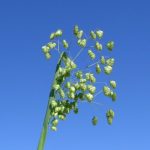Shivery Grass

Common name
Shivery Grass
Scientific Name
Briza minor
Type of plant
Grasses (Family Poaceae)
About this weed
Originally from north Africa, temperate western Asia, southeastern and southwestern Europe, Shivery Grass was probably introduced as a seed contaminant in crops and as ornamental plants.
Description
Shivery Grass is a slender, annual, tufted grass growing to 0.5m high with a loose cluster of small shivering, nodding green spikelets that are small and more numerous than B. maxima. The spikelets are produced in spring and the seedbank persists for up to 3 years. Fire promotes germination of soil-stored seed.
Impact on Bushland
Not available.
Location
Widely distributed in the South-West Province in gardens, wastelands, wetlands and granite rocks. Shivery Grass prefers loam, sand, clay and laterite soils. In southern Western Australia it is a problem in cereal crops.
Priority for removal
Unknown: if established may impact native plant communities.
Management (hand)
Try to prevent seed set by hand pulling in July, August and September.
Management (herbicide)
Spray at 3-5 leaf stage with Fusilade® Forte at 16 ml/10 L or 800 ml/ha (based on 500 L water/ha) + wetting agent or for generic fluazifop-p (212g/L active ingredient) 10ml/10L or 500ml/ha + wetting agent. Optimum months to spray are July to September then repeat treatment for 2 – 3 years.
Flowering month/s
September, October
Flower colour/s
Green
Information source
https://florabase.dpaw.wa.gov.au/browse/profile/245
Additional information
https://florabase.dpaw.wa.gov.au/weeds/swanweeds/
Hussey, B.M.J., Keighery, G.J., Dodd, J., Lloyd, S.G. and Cousens, R.D. (2007) Western weeds. A guide to the weeds of Western Australia, Second Edition, The Weeds Society of Western Australia, Victoria Park, Western Australia.

